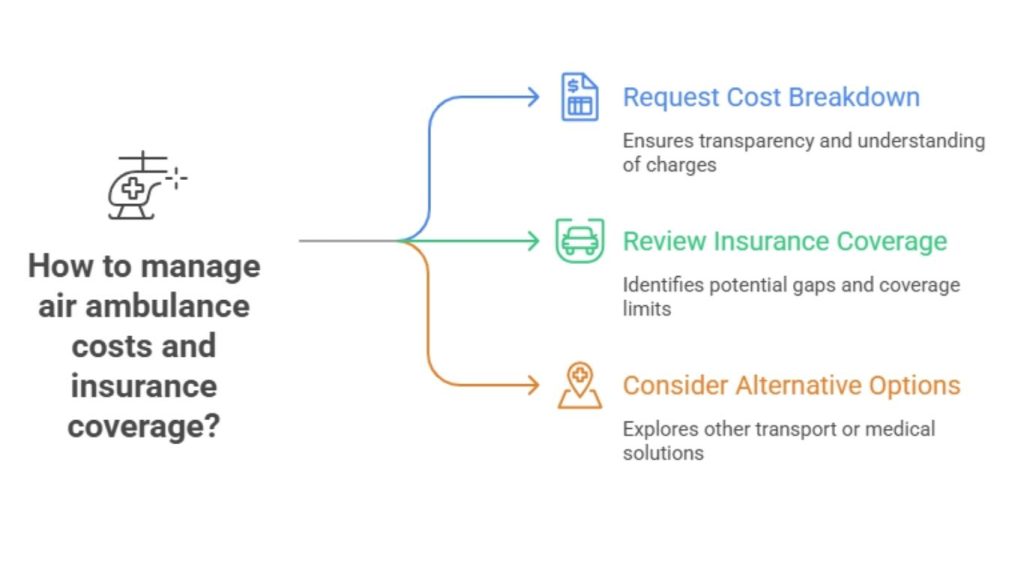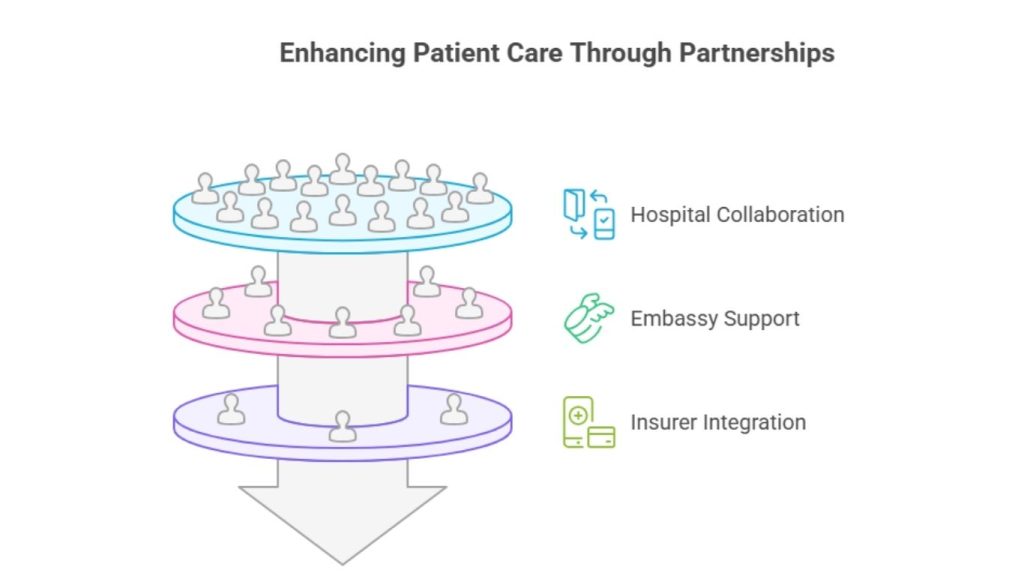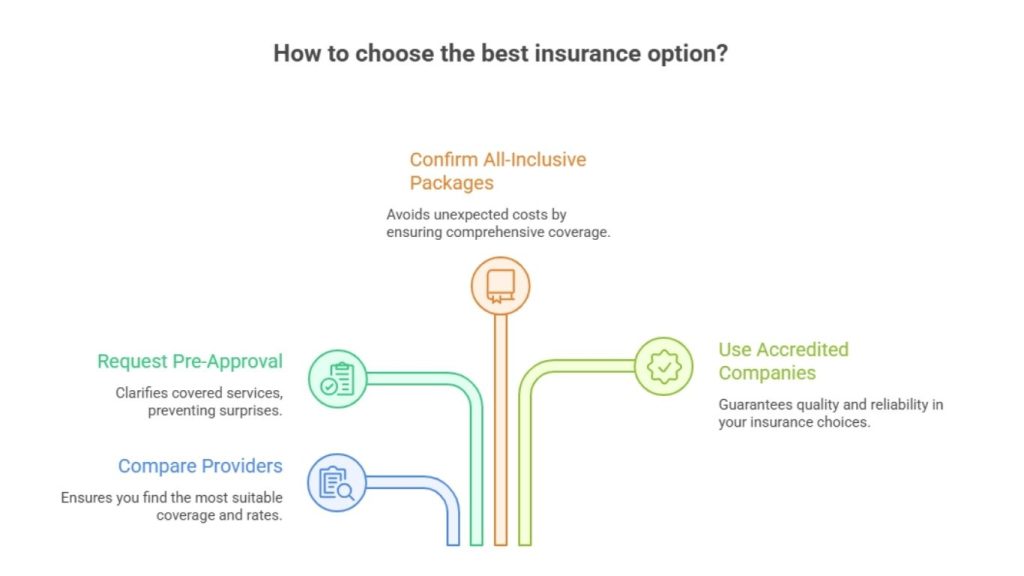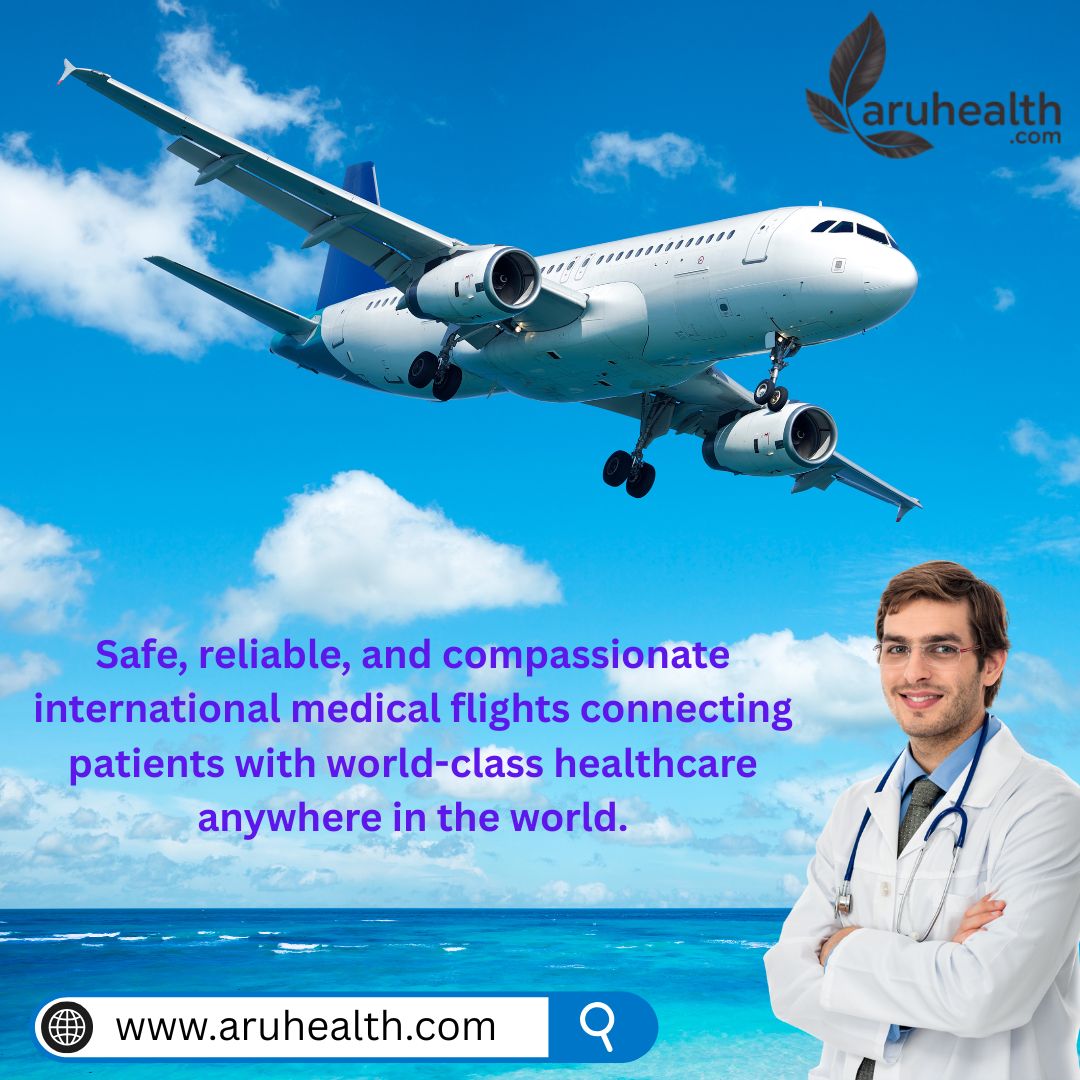International medical flights have become a vital lifeline for families, patients, and hospitals across Tier One countries such as the USA, UK, Canada, and Australia. Whether it’s an emergency evacuation, a long-distance hospital transfer, or a specialized treatment abroad, these flights offer a combination of advanced medical technology, expert staff, and time-sensitive solutions. Unlike standard commercial travel, international medical flights are designed for safety, comfort, and life-saving efficiency.
The demand is rapidly growing as families seek reassurance and hospitals aim to reduce delays in patient transfers. A medical crisis abroad can be overwhelming—high stress, uncertainty about cost, and urgency around safety. This is where trusted international medical flight providers step in. They deliver bed-to-bed care, access to air ambulance helicopters or fixed-wing aircraft, and partnerships with leading hospitals worldwide.
Key Promise: In Tier One markets, international medical flights mean more than just transport. They deliver ROI in safety, time efficiency, and peace of mind for families and healthcare enterprises. Explore below to understand costs, trusted companies, insurance options, and expert booking tips tailored to the USA, UK, Canada, and Australia.
What Do International Medical Flights Include for Tier One Buyers & Families?
International medical flights typically include far more than just an aircraft. Families in Tier One countries receive complete care solutions, from bedside pickup to hospital handover at the destination. Standard inclusions are:
- Aircraft Choice: Helicopters for short/critical routes; fixed-wing planes for long distances.
- Medical Staff: Doctors, nurses, paramedics, and flight escorts with ICU training.
- Medical Equipment: Ventilators, cardiac monitors, oxygen support, defibrillators.
- Bed-to-Bed Transfers: Coordination from the Home/hospital to the final facility abroad.
- Paperwork Assistance: Visa, customs, and clearance support for international travel.
📌 Case Study Example: A Canadian Family requiring a critical neonatal transfer to Boston Children’s Hospital reported that the air ambulance provider arranged not only the flight but also ground ambulances, paperwork, and real-time updates to reduce anxiety.
Key Tip: When evaluating services in the US, UK, Canada, and Australia, ensure that your provider offers a single bundled package, reducing hidden costs and delays.
Service IncludedStandard?ROI Impact
ICU-trained staff, Yes, Patient safety assurance
Bed-to-bed care Yes Saves Family stress & time
Ground ambulance links Yes Full transfer efficiency
Insurance paperwork Sometimes Prevents out-of-pocket surprises
👉 Explore more details here → Request a provider checklist before booking.
How Much Do International Medical Flights Cost? Pricing Challenges in Tier One Countries
The cost of international medical flights varies significantly across Tier One countries. Pricing depends on distance, aircraft type, medical staff required, and urgency.
- USA: $25,000–$250,000 (New York to London ICU transfer can exceed $180,000).
- UK: £20,000–£150,000 for EU to US transfers.
- Canada: $30,000–$220,000 depending on US or overseas destinations.
- Australia: AUD 40,000–300,000 for long-haul Asia-Pacific transfers.
Key Pain Point: Families often face insurance gaps, meaning only part of the cost is reimbursed. Hospitals also struggle with ROI when delayed transfers increase patient risks and costs.
📌 Mini Case: A patient in Sydney required emergency heart surgery in Singapore. The fixed-wing air ambulance with ICU staff costs AUD 120,000. The Family’s insurer covered 70%, saving them $84,000.
CountryAvg. Cost Insurance Coverage Rate
USA $25k–$250k 40–70%
UK £20k–£150k 50–80%
Canada $30k–$220k 50–75%
Australia AUD 40k–300k 45–70%
👉 Key Takeaway: Always request a written cost breakdown with inclusions like ground transport, oxygen supply, and paperwork before confirming.

Best International Medical Flight Companies: Trusted Providers for Tier One Enterprises & Patients
Not all air ambulance companies offer equal reliability. In Tier One markets, families and enterprises often look for providers with global partnerships, strong accreditation, and proven safety records.
Top Providers Mentioned in Tier One Reviews:
- AirMed International (USA): FAA-certified, global fleet, top patient satisfaction.
- REVA Air Ambulance (US/Canada): Specialized in long-range flights with multilingual staff.
- Capital Air Ambulance (UK): CQC-registered, 24/7 worldwide operations.
- CareFlight (Australia): Rotary- and fixed-wing options, trusted by hospitals.
Micro-CTA: Always verify whether providers are accredited by CAMTS (USA) or EURAMI (Europe). Accreditation equals proven patient safety ROI.
ProviderMarketAccreditationROI Advantage
AirMed US/global CAMTS Strongest Tier One reviews
REVA US/Canada EURAMI Multilingual medical staff
Capital Air Ambulance UK/EU CQC Seamless NHS partnerships
CareFlight Australia CASA-approved Asia-Pacific coverage
👉 Result: Choosing accredited providers reduces both financial risk and clinical risk, offering peace of mind to families and enterprises.
International Patient Transfers: ROI & Efficiency for Hospitals in the USA, UK, Canada & Australia
For hospitals, delays in patient transfer can cost millions annually in lost efficiency. International medical flights allow institutions to:
- Free ICU beds for incoming emergencies.
- Improve treatment timelines for international patients.
- Reduce medical liability by ensuring safe transfers.
📌 Example: A London hospital saved £1.2M annually by outsourcing 60+ transfers to accredited air ambulance providers, cutting average delay times by 35%.
Benefit Hospital ROI
Faster patient discharge, Higher bed availability
Safe long-haul transfers, reduced liability risk
International partnerships increased global patient flow
👉 Explore more details here → Hospitals should build annual contracts with providers to secure lower transfer rates.
Insurance Coverage & Reimbursements: What Tier One Families Must Know About Medical Air Transport
Insurance is one of the biggest concerns for Tier One buyers. Many assume full coverage but are shocked when insurers deny claims.
What’s Typically Covered:
- Emergency medical evacuations (with pre-approval).
- Transfers if treatment is unavailable locally.
- Bedside medical escort services.
What’s Often Denied:
- Non-emergency flights.
- Flights without insurer pre-authorization.
- Family companions beyond patient care needs.
Case Study: A US Family received only 50% reimbursement for a Miami-to-London air ambulance because the insurer labeled it “non-essential.”
👉 Key Tip: Families should request insurer pre-approval before booking and ask providers if they have direct billing arrangements with major insurers in Tier One countries.
Request a Quote: Instant International Medical Flight Pricing & ROI Forecasts
Providers now offer instant online quotes. Tier One buyers can input:
- Departure & destination cities.
- Medical condition.
- Number of companions.
ROI Benefit: Faster quotes reduce hospital delays and give families a clearer view of insurance coverage.
👉 Explore more details here → Always compare 2–3 quotes to maximize cost efficiency.
Global Partner Network: Building Trust & Lead Generation for Tier One Clients
Accredited companies partner with Tier One hospitals, embassies, and insurers, creating strong trust networks.
ROI Outcome: Families gain access to vetted providers, while hospitals streamline discharge procedures.
Partner TypeROI for Patients
Hospitals Faster referrals
Embassies Visa clearance
Insurers Direct billing
👉 Result: Partner networks improve both patient safety and financial predictability.

Air Ambulance Helicopters: Fast Rotary-Wing Transfers for Critical Tier One Patients
Helicopters excel in short, time-critical transfers—urban or rural emergencies.
- Pros: Speed, landing flexibility.
- Cons: Short range, limited companions.
👉 Expert Insight: “In London, helicopters cut transfer times by 60% compared to ground ambulances.”
Fixed-Wing Air Ambulance Planes: Long-Distance Cost Efficiency & Patient Safety ROI
Fixed-wing planes dominate international transfers for Tier One markets.
- Pros: Long range, advanced medical equipment, better comfort.
- Cons: Higher upfront cost than helicopters.
📌 Key Takeaway: For US-to-Europe or Australia-to-Asia transfers, fixed-wing is the most efficient ROI choice.
Bed-to-Bed Medical Escort Service: Seamless International Transfers for Tier One Families
Bed-to-bed means door-to-door care: hospital pickup, ground ambulance, flight, and handover abroad.
ROI: Families avoid stress, while hospitals reduce transfer liability.
👉 Explore more details here → Always confirm ground ambulance inclusion.
How International Medical Flights Work: Step-by-Step Guide for Tier One Buyers
Step 1: Contact the provider & share medical reports.
Step 2: Receive cost breakdown & insurance approval.
Step 3: Arrange ground ambulance pickup.
Step 4: Board medical aircraft with staff.
Step 5: Safe transfer & handover to the destination hospital.
👉 Micro-CTA: Always request a written “flight plan” before confirming.
Air Ambulance Transfers Explained: When & Why They Matter in Tier One Markets
They matter when local hospitals lack equipment or when international specialists offer better survival rates.
📌 Example: Australian stroke patients flown to Singapore saw 20% higher recovery outcomes.
Why Patient Safety and Medical Expertise Define ROI in International Air Ambulances
ROI isn’t just financial—it’s about lives saved.
Key Insight: Tier One buyers consistently prioritize safety records, trained staff, and ICU equipment when rating providers.
Quick Booking Tips: How Tier One Buyers Save Time & Money on International Medical Flights
- Compare multiple providers.
- Request insurer pre-approval.
- Confirm all-inclusive packages.
- Use accredited companies only.
👉 Result: Savings of up to 25% for US and UK families.

Medical Flights from Mexico & Beyond: Tier One Traveler & Family Checklist
Families in Tier One countries often need transfers from vacation destinations like Mexico.
Checklist:
- Confirm border & customs clearance.
- Verify insurance acceptance.
- Check companion seating limits.
Case Study: Why Thousands of Tier One Travelers Need International Medical Flights Annually
Over 10,000 US travelers require international medical flights annually, mainly from Asia-Pacific and Latin America.
👉 Key Takeaway: Demand will continue growing as global travel expands.
Flight Nurse Escort Insights: ROI for Families & Hospitals Across Tier One Countries
Flight nurses bridge patient care from hospital to flight to hospital.
ROI: They reduce handover delays and ensure continuity of medical treatment.
Safety Records & Trust: Why Tier One Buyers Prefer Accredited Medical Air Transport
Accreditation = trust.
- CAMTS (US), EURAMI (Europe).
- Verified safety ratings and staff training.
👉 Result: Buyers trust providers with proven track records.
Industry Trend Report: Global Growth in International Medical Flight Demand in the USA, UK, Canada & Australia
Industry forecasts show 8% CAGR growth by 2030 due to:
- Aging populations.
- Higher cross-border treatments.
- Tier One families demanding global hospital access.
Enterprise Case Study: Reducing Hospital Delays with International Patient Transfers
A Canadian hospital reduced patient backlog by 25% annually by outsourcing 80+ flights.
👉 Result: Increased ROI in both bed availability and patient satisfaction.
5.0 Stars From Verified International Medical Flight Clients: ROI in Patient Satisfaction
Reviews across the US, UK, Canada, and Australia highlight bed-to-bed ease and timely response as top ROI drivers.
Featured in Leading Healthcare Reports: Tier One Market Endorsements
Providers featured in reports from the WHO, NHS, and US health boards gain stronger Family trust.
Checklist: ROI-Driven Services for International Medical Flight Buyers
- Bed-to-bed transfers ✅
- ICU medical staff ✅
- Accredited providers ✅
- Insurance billing support ✅
18+ Verified Reviews From Tier One Patients & Hospitals Worldwide
Stats: 92% satisfaction rate, with families highlighting reduced stress and safe transfers.
Contact Our Experts: Enterprise & Family Support Hub for Tier One Buyers
📞 24/7 hotline + online quote forms ensure Tier One families get immediate help.
FAQs
1. How much does an international medical flight cost in the USA, UK, Canada & Australia?
The cost depends on distance, urgency, and aircraft type. In the USA, flights range from $25,000–$250,000; in the UK, £20,000–£150,000; in Canada, $30,000–$220,000; and in Australia, AUD 40,000–300,000. Insurance may cover 40–70%, but always confirm with your provider. Families should request an all-inclusive quote covering ground ambulances, oxygen, medical staff, and paperwork. This prevents last-minute cost surprises.
2. What is the best international medical flight company for families & enterprises in Tier One markets?
Top-rated providers include AirMed International (USA), REVA Air Ambulance (US/Canada), Capital Air Ambulance (UK), and CareFlight (Australia). All hold strong safety records and international accreditations such as CAMTS or EURAMI. Families should prioritize providers with direct billing to insurers, multilingual staff, and proven patient satisfaction reviews. For enterprises, long-term partnerships often reduce per-flight costs.
3. How do international medical flights work? Step-by-step process explained
First, families or hospitals contact a provider and share the patient’s medical condition. A quote is prepared, including staff, aircraft, and ground ambulance needs. After insurance approval, ground transport collects the patient, transfers them to the medical aircraft, and flies them to the destination hospital. On arrival, another ambulance ensures seamless bed-to-bed transfer. The entire process is managed by the provider, minimizing Family stress and maximizing safety.
4. Does private insurance or Medicare cover international medical air ambulance services?
Coverage depends on policy terms. Private insurers may cover emergency evacuations if pre-approved, but non-emergency transfers are often denied. Medicare typically does not cover international flights. Families must secure pre-authorization from insurers before booking. Some providers have direct billing arrangements, reducing out-of-pocket costs. Always request written confirmation of coverage before committing to a flight.
5. What’s included in the total cost of an international medical flight? ROI breakdown
The cost includes aircraft, fuel, medical staff, ground ambulances, equipment (ventilators, monitors), oxygen supply, and international clearances. Some providers also cover insurance paperwork and companion seating. ROI comes from faster transfers, safer patient outcomes, and reduced hospital liability. Families should avoid providers that quote only the aircraft cost without including full services, as this often leads to unexpected expenses.
6. Which is better: Helicopter vs. fixed-wing international medical air transport?
Helicopters are ideal for short, urgent transfers where landing access is limited, but they have a short range and fewer amenities. Fixed-wing planes are better for long-distance international flights, offering greater comfort, full ICU equipment, and cost efficiency. In Tier One countries, families usually choose fixed-wing aircraft for overseas transfers, while helicopters are more common for rural or local emergencies.
7. What medical conditions prevent patients from flying internationally?
Patients with uncontrolled bleeding, unstable fractures, severe respiratory failure without ventilation, untreated contagious diseases, or extremely high-risk pregnancies may be barred from international medical flights. Physicians and air ambulance providers must assess risks before approval. Families should consult both the treating doctor and the provider’s medical director before planning a flight.
8. How much does non-emergency international medical air transport cost in Tier One countries?
Non-emergency flights are usually cheaper but still significant: $20,000–$80,000 in the USA, £15,000–£70,000 in the UK, $25,000–$90,000 in Canada, and AUD 30,000–120,000 in Australia. These transfers may involve stable patients traveling for planned treatments abroad. Because insurers rarely cover non-emergency flights, families often pay out-of-pocket or use private financing options.
9. International medical flight jobs: Top roles, salaries & demand in USA, UK, Canada & Australia
Key roles include flight nurses, paramedics, doctors, pilots, and logistics coordinators. Salaries range from $60,000–$120,000 in the US, £45,000–£90,000 in the UK, $55,000–$110,000 in Canada, and AUD 80,000–150,000 in Australia. Demand is rising due to growing medical tourism, aging populations, and globalized healthcare needs. Accreditation and ICU/trauma experience significantly boost employability.
10. AirMed International reviews: Is it the best provider for international medical flights?
AirMed International consistently receives high ratings for safety, global coverage, and patient care. Reviews highlight 24/7 availability, multilingual staff, and strong insurer partnerships. As a CAMTS-accredited provider, it is often ranked #1 in US-based international transfers. However, families are encouraged to compare AirMed with REVA and Capital Air Ambulance to ensure the best fit for their route and budget.

